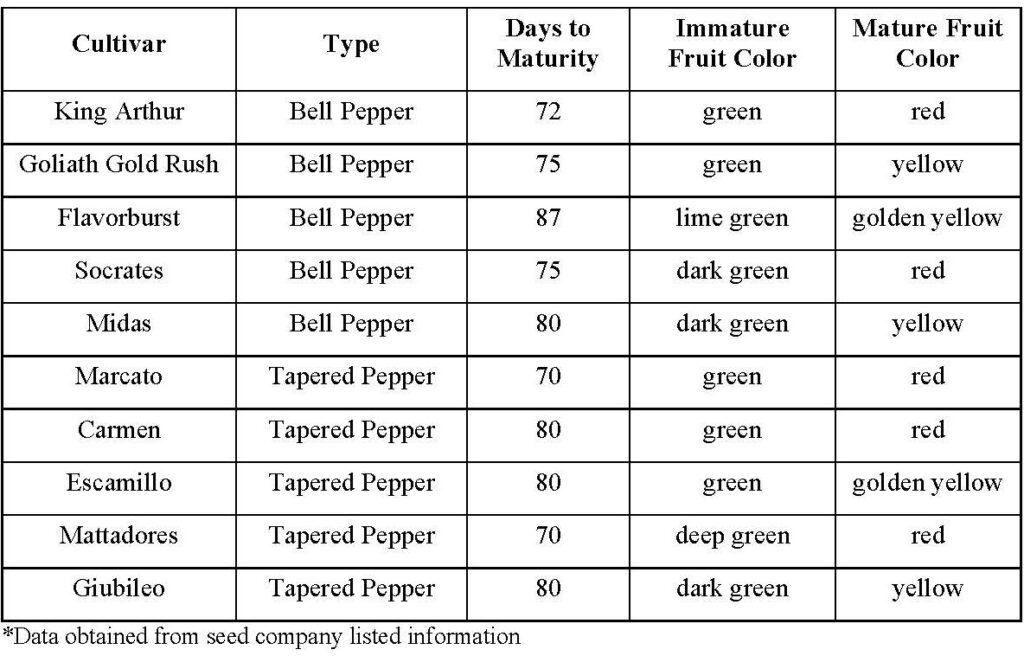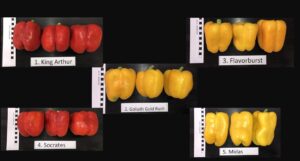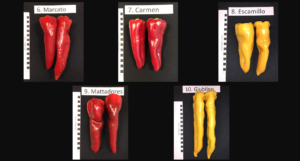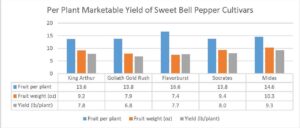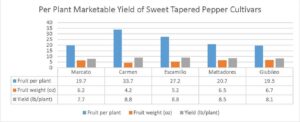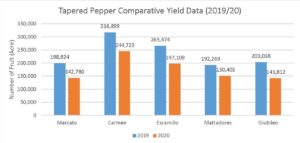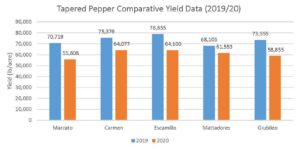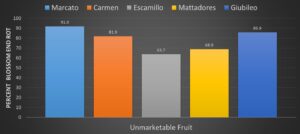There is still time to select sweet pepper varieties for this summer. During the 2020 growing season, I evaluated a new batch of five sweet bell pepper varieties. I also evaluated five sweet tapered pepper varieties for a second season. All varieties (Table 1, Figures 1 & 2) were grown in a high tunnel at the Purdue Student Farm, West Lafayette IN. Peppers were seeded April 23, 2020, and transplanted into a 30’ x 96’ high tunnel on May 21, 2020, with an in-row spacing of 1.5 feet and between-row spacing of 4 feet. (7,260 plants per acre). Plant nutrient management was done according to soil test results.
Table 1. Colored sweet bell and tapered pepper cultivar characteristics*.
All varieties evaluated performed well under high tunnel conditions (Figures 3 & 4), despite issues with the trellising system that resulted in plant lodging. Flavorburst (yellow bell), one of the most consistent performers in our variety trials, once again produced the highest number of marketable fruits per plant. Flavorburst is a sturdy relatively compact plant and continues to produce fruit all season long. This variety is also the least affected by blossom end rot (BER) (Figure 7). Midas (yellow bell pepper), a variety evaluated for the first time in 2020, was the surprise of the season. The fruit was very uniform, elongated, and weighs about 10 oz. This variety is a top performer producing a marketable yield of 106,000 fruits per acre, weighing 67,500 lb. Most of the Midas unmarketable fruit (70.2%) was culls due to BER (Figure 7), but the abundance of large fruit made up for the loss in marketable fruit. If you are looking for a red bell pepper, then I would suggest Socrates (Figure 3). Socrates produced less BER culls than King Arthur (Figure 7). Goliath Gold Rush produced a disappointing yield (49,232 lb./A). This blocky pepper is very prone to getting BER and also suffered from other disqualifying quality issues. The fruits were at times covered in necrotic spots with cracks on the fruit’s shoulders.
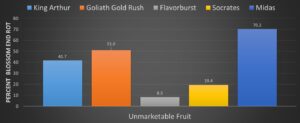
Figure 7. BER of colored sweet bell pepper cultivars showed as a percent of total unmarketable fruit.
Carmen (red tapered) and Escamillo (yellow tapered counterpart to Carmen) outperformed all other tapered pepper varieties in terms of marketable fruit numbers, 244,723 and 197,109 fruit per acre, respectively (Figure 4). I regard Carmen as an industry standard and therefore include it every year in the variety trials. The tapered pepper varieties did not differ significantly in terms of marketable yield production. However, Carmen and Escamillo produced the highest marketable yield (about 64,000 lb./A). In 2019, Carmen and Escamillo produced on average 17.6% and 23% higher marketable yields, respectively, compared to 2020 (Figures 5 & 6). In fact, all tapered pepper variety marketable yields were higher in the 2019 season. The comparative yields indicates that growing conditions during a specific season can have a major impact on yield, positive or negative.
On average Carmen and Escamillo produced fruit that is 7.5 inches long. If you are interested in growing very long tapered peppers, then you would appreciate Giubileo (yellow, 10 inches long) and Mattadores (red, 9 inches long). However, Giubileo is also very prone to getting BER. Eighty-six percent of the total unmarketable fruit was BER culls (Figure 8). Marcato (red tapered) was the most affected by BER. These varieties produced beautiful fruit but the extra-long fruit (>9 inches) makes them prone to BER under suboptimal growing conditions. Despite the challenges all tapered pepper varieties experienced with BER, they still produced some of the highest yields in the variety trial. Assess your market and choose varieties accordingly.
